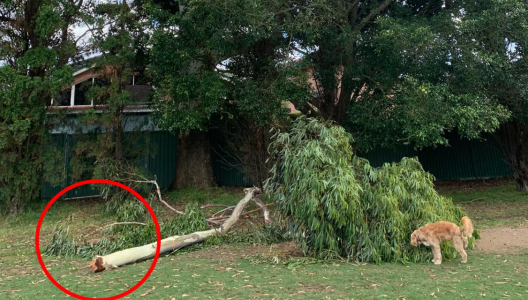Grandparents, beware: This 'ticking time bomb' park could have been packed with kids
By
- Replies 0
As the Australian summer approaches, bringing with it the promise of sunny days and outdoor activities, a recent incident reminds us of the hidden dangers in our parks.
A massive gum tree branch plummeted to the ground in Bales Park, a northern suburb of Willoughby in Sydney.
The fallen branch, discovered by a vigilant dog walker, could have easily been a disaster had it occurred when the park usually bustles with children playing sports.
The branch's weight, estimated to be several hundred kilograms, is a testament to nature's sheer power and unpredictability.
Gum trees have earned a notorious reputation for their propensity to drop branches without warning, earning them the ominous nickname of 'widow makers'.
As Royal Botanic Gardens chief botanist Brett Summerell explained, this isn't a term to be taken lightly.
The name harks back to a time when forestry was a predominantly male occupation, and the sudden and tragic loss of workers to falling limbs often left families without husbands and fathers.
The reasons why gum trees shed their branches are not entirely understood, but it is generally believed to be a survival mechanism for the tree to sacrifice a part of itself to endure environmental stresses rather than succumb entirely.
Some species of gum trees can reach staggering heights of up to 60 metres, meaning that the branches can become incredibly heavy and, if they fall, pose a significant threat to anyone below.
Tragically, there have been fatal incidents in the past.
In February, a 22-year-old woman lost her life when a branch fell on her as she sought shade under a gum tree in Adelaide.
In another close call, a two-tonne branch fell at the adventure park TreeClimb in Adelaide, narrowly missing children who were present at the time.
The most straightforward advice is to avoid sitting or playing directly under these trees, especially during hot, humid, or windy weather, which can increase the likelihood of branches falling.
Older and less healthy trees are particularly suspect and should be treated cautiously.
For those with gum trees on their property or in nearby public spaces, it is wise to hire a professional arborist.
These specialists can assess the trees' health, identifying any signs of disease, damage, or physical stress that could cause them to drop branches.
Regular checks and maintenance can help prevent accidents and ensure the safety of everyone enjoying the great outdoors.
Two campers were amazed to find a gum tree with unusual ‘fingers’ extending outward, encircling a fence wire.
The spotted gum's remarkable growth pattern has captured the attention of tree enthusiasts and sparked lively discussions among an online community dedicated to Australian eucalypts. You can read more about it here.

Have you had any close encounters with falling branches, or do you have any tips on tree safety? Share your stories and advice with us in the comments below.
A massive gum tree branch plummeted to the ground in Bales Park, a northern suburb of Willoughby in Sydney.
The fallen branch, discovered by a vigilant dog walker, could have easily been a disaster had it occurred when the park usually bustles with children playing sports.
The branch's weight, estimated to be several hundred kilograms, is a testament to nature's sheer power and unpredictability.
Gum trees have earned a notorious reputation for their propensity to drop branches without warning, earning them the ominous nickname of 'widow makers'.
As Royal Botanic Gardens chief botanist Brett Summerell explained, this isn't a term to be taken lightly.
The name harks back to a time when forestry was a predominantly male occupation, and the sudden and tragic loss of workers to falling limbs often left families without husbands and fathers.
The reasons why gum trees shed their branches are not entirely understood, but it is generally believed to be a survival mechanism for the tree to sacrifice a part of itself to endure environmental stresses rather than succumb entirely.
Some species of gum trees can reach staggering heights of up to 60 metres, meaning that the branches can become incredibly heavy and, if they fall, pose a significant threat to anyone below.
Tragically, there have been fatal incidents in the past.
In February, a 22-year-old woman lost her life when a branch fell on her as she sought shade under a gum tree in Adelaide.
In another close call, a two-tonne branch fell at the adventure park TreeClimb in Adelaide, narrowly missing children who were present at the time.
The most straightforward advice is to avoid sitting or playing directly under these trees, especially during hot, humid, or windy weather, which can increase the likelihood of branches falling.
Older and less healthy trees are particularly suspect and should be treated cautiously.
For those with gum trees on their property or in nearby public spaces, it is wise to hire a professional arborist.
These specialists can assess the trees' health, identifying any signs of disease, damage, or physical stress that could cause them to drop branches.
Regular checks and maintenance can help prevent accidents and ensure the safety of everyone enjoying the great outdoors.
Two campers were amazed to find a gum tree with unusual ‘fingers’ extending outward, encircling a fence wire.
The spotted gum's remarkable growth pattern has captured the attention of tree enthusiasts and sparked lively discussions among an online community dedicated to Australian eucalypts. You can read more about it here.
Key Takeaways
- Aussies are being warned to have their gum trees checked, particularly ahead of summer, due to the risk of branches falling without warning.
- A heavy branch fell in a park commonly frequented by children in Sydney's northern suburb of Willoughby, highlighting the safety risk.
- Gum trees, sometimes called 'widow makers', can drop branches as a resilience measure to protect the tree itself.
- It is recommended to avoid sitting under gum trees and to employ an arborist to assess the health of the trees and mitigate the risk of falling branches.








